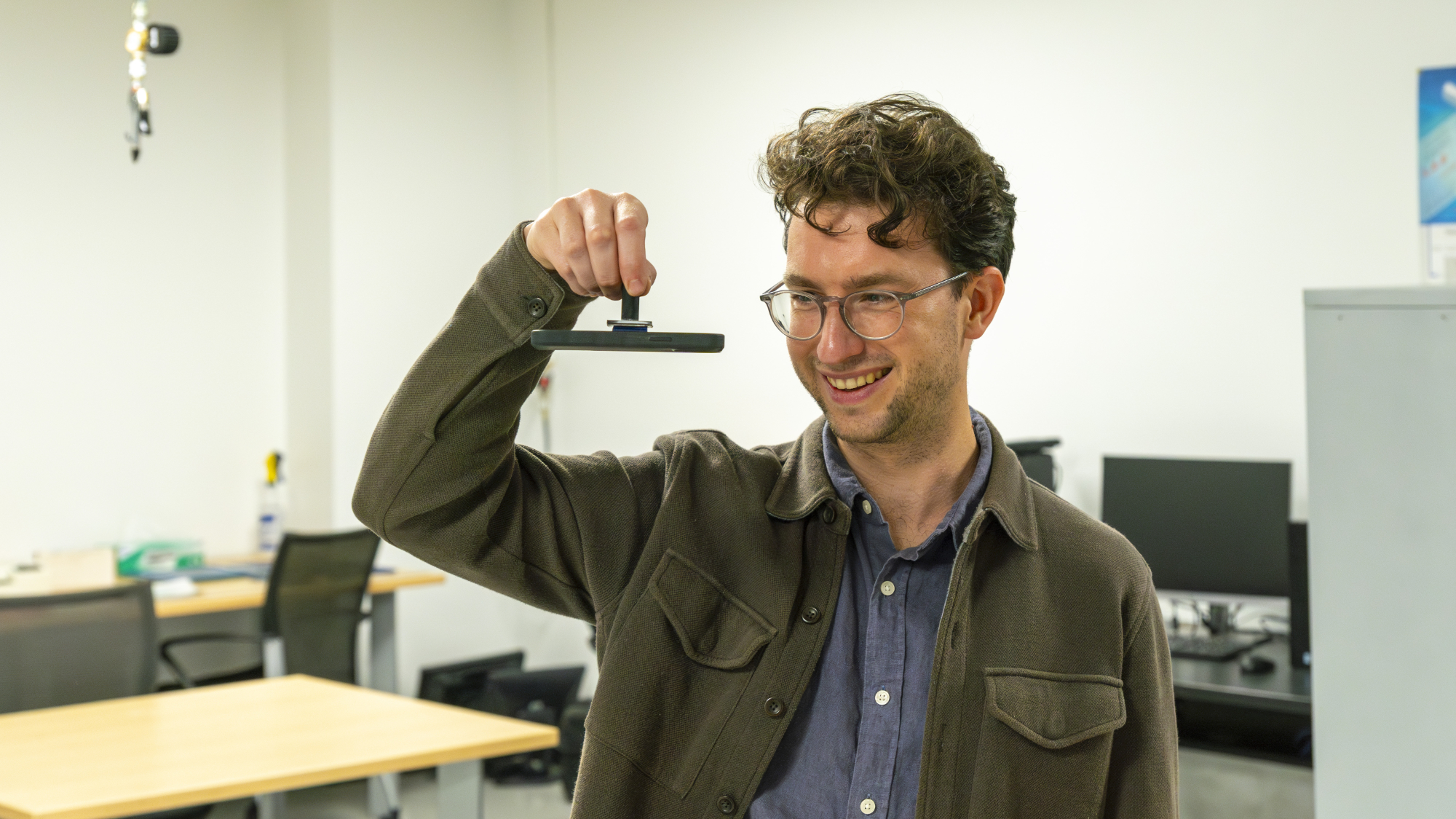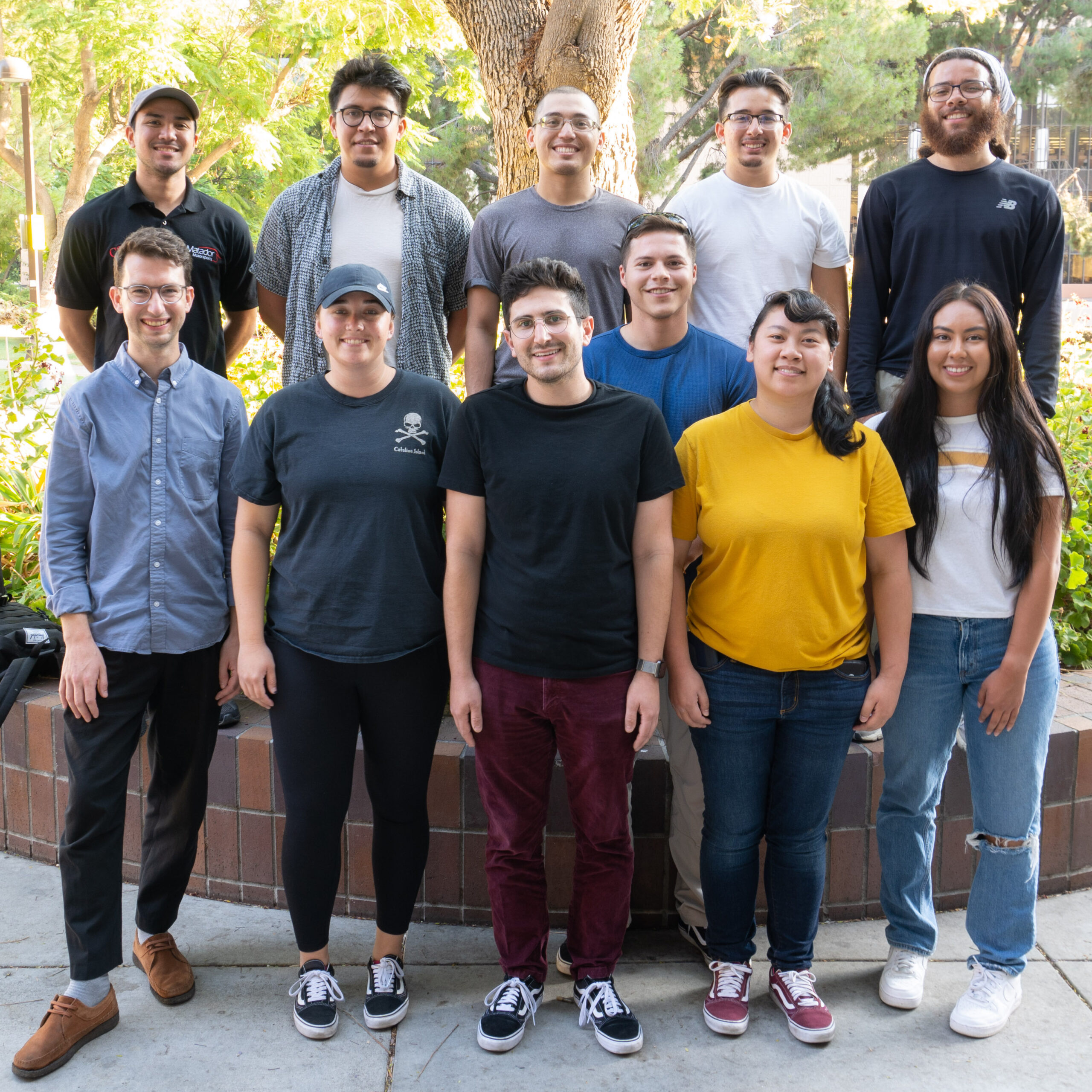The Wonders of Gecko-Inspired Adhesives and Dr. Jamie Booth

Dr. Jamie Booth using a test adhesive on a cellphone. Photo by Spencer Hutchison
When we see a gecko effortlessly climbing walls or ceilings, it appears almost magical. But this extraordinary ability is rooted in the gecko’s toe-pads, which feature an intricate structure of hair-like fibers. Thanks to a prestigious $300,000 grant from the National Science Foundation (NSF), Dr. Booth and his team of dedicated students are delving deep into the science behind this phenomenon, exploring how we can reproduce gecko-inspired adhesives, with the potential to revolutionize various fields.
This grant is awarded through the Mechanics of Materials and Structures (MOMS) program, is dedicated to advancing fundamental research in mechanics, materials, and structures. Dr. Booth’s specific research focus lies in exploring the “Origins of Statistical Variation in Strength in Micropatterned Adhesive Contacts”, or simply investigating why there are differences in how well tiny patterns stick to surfaces and figuring out what causes these differences.
And within the college, Dr. Booth’s Bioinspired Mechanics Lab is well-suited to do this investigation. By studying these gecko adhesives and the fibers of geckos, it’ll offer numerous potential applications, from climbing robots and industrial automation to biomedical devices and wearable technologies. The gecko’s unique ability to switch between strong attachment and easy detachment could revolutionize these fields.
However, translating the principles governing gecko adhesion into practical engineering solutions poses a significant challenge. Dr. Booth emphasizes that the foundation of these solutions lies in biology—a testament to the captivating interplay between the natural world and engineering that still has many unknowns.
Thankfully, Dr. Booth’s research is far from a solitary endeavor. He actively involves both graduate and undergraduate students from CSUN in his laboratory and classes. The students play a vital role in experimenting and building an understanding the impact of surface roughness and the mechanics of defect formation.

Figure 1 Dr Jamie Booth (Bottom Left) with his graduate students. Photo by Dr. Jamie Booth.
“I believe it is essential to approach teaching with enthusiasm because when you show up with passion, it often resonates with the students. You get back what you put in.” Dr. Booth emphasizes. “For instance, in the NSF project we’re currently working on, we have incorporated a course-based element. The goal is to introduce a project where students can contribute real and meaningful data, moving away from merely a superficial exercise.”
The process of developing and testing these gecko-inspired adhesives is a complex journey. In their laboratory, students are actively engaged in every step of the process alongside Dr. Booth. They begin by fabricating the adhesives using a meticulous molding process. The molds themselves are designed by students and then extensively produced in their machine shop. These same students are also responsible for the molding process, carefully crafting accurate adhesive samples for testing.
To gauge the adhesive’s load-bearing capacity, Dr. Booth’s team has devised a solid experimental platform. As the adhesive is brought into contact with a surface and subsequently retracted, the forces involved are carefully measured. Visualizing the interface and gaining insights into how defects propagate or individual fibers detach are pivotal to their research. To facilitate this, the students have engineered a specialized setup for contact visualization, delivering high-resolution images of the contact and non-contact regions using precise illumination techniques.
After exploring this contact visualization through practical work, students then migrate to the numerical side of their research. Various types of simulations are employed to model different processes occurring across varying length scales. These simulations offer insights into the formation of defects over rough surfaces, the mechanical performance of individual structures, and even the behavior of an array of structures within an adhesive patch. This comprehensive approach spans a wide range of scales, addressing the complexities of the defects and finding possible adhesive solutions from there.
When asked about why this project in particular, he had this to say: “I’m a fracture mechanics person,” Dr. Booth says. “I am fascinated by the study of fracture in engineering materials. There are so many interesting techniques used in nature to prevent cracks from growing through structures. People most likely don’t think of geckos as preventing cracks from causing fracture when they see them climbing walls, and that is part of what makes it such a fun application of mechanical engineering.”
The NSF grant encompasses a three-year duration, during which the team hopes to accomplish their predefined goals. However, the research itself possesses the potential for continued exploration. Dr. Booth explains that as long as intriguing avenues and unanswered questions await exploration, the research can extend its horizons. The duration of the research journey will ultimately hinge on the discoveries made and the subsequent directions their investigations take.
As the grant-funded research progresses, Dr. Booth and his team are well on their way to shedding light on the secrets of gecko adhesion and revolutionizing the future of adhesives and materials science. This endeavor exemplifies how inspiration from the natural world yields innovative solutions for our modern problems.
M-STEP: A Kickstart to Success in Engineering and Computer Science
November 27, 2023From Bahrain to CSUN: Sara Ali’s Journey to Success
November 13, 2023Awarded Education: Dr. Shawn Sun’s Commitment to Student Growth
October 30, 2023
Leave a reply Cancel reply
-
Student organizations build community, opportunity
November 30, 2012 -
A Laboratory for the Future
June 16, 2010 -
CECS Students Shine in Solar Project
June 16, 2010
